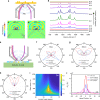Advances of surface-enhanced Raman and IR spectroscopies: from nano/microstructures to macro-optical design
- PMID: 34349103
- PMCID: PMC8338991
- DOI: 10.1038/s41377-021-00599-2
Advances of surface-enhanced Raman and IR spectroscopies: from nano/microstructures to macro-optical design
Abstract
Raman and infrared (IR) spectroscopy are powerful analytical techniques, but have intrinsically low detection sensitivity. There have been three major steps (i) to advance the optical system of the light excitation, collection, and detection since 1920s, (ii) to utilize nanostructure-based surface-enhanced Raman scattering (SERS) and surface-enhanced infrared absorption (SEIRA) since 1990s, and (iii) to rationally couple (i) and (ii) for maximizing the total detection sensitivity since 2010s. After surveying the history of SERS and SEIRA, we outline the principle of plasmonics and the different mechanisms of SERS and SEIRA. We describe various interactions of light with nano/microstructures, localized surface plasmon, surface plasmon polariton, and lightning-rod effect. Their coupling effects can significantly increase the surface sensitivity by designing nanoparticle-nanoparticle and nanoparticle-substrate configuration. As the nano/microstructures have specific optical near-field and far-field behaviors, we focus on how to systematically design the macro-optical systems to maximize the excitation efficiency and detection sensitivity. We enumerate the key optical designs in particular ATR-based operation modes of directional excitation and emission from visible to IR spectral region. We also present some latest advancements on scanning-probe microscopy-based nanoscale spectroscopy. Finally, prospects and further developments of this field are given with emphasis on emerging techniques and methodologies.
© 2021. The Author(s).
Conflict of interest statement
The authors declare no competing interests.
Figures













Similar articles
-
Latest Advances in Metasurfaces for SERS and SEIRA Sensors as Well as Photocatalysis.Int J Mol Sci. 2022 Sep 13;23(18):10592. doi: 10.3390/ijms231810592. Int J Mol Sci. 2022. PMID: 36142501 Free PMC article. Review.
-
Surface-Enhanced Raman Scattering and Surface-Enhanced Infrared Absorption by Plasmon Polaritons in Three-Dimensional Nanoparticle Supercrystals.ACS Nano. 2021 Mar 23;15(3):5523-5533. doi: 10.1021/acsnano.1c00352. Epub 2021 Mar 5. ACS Nano. 2021. PMID: 33667335 Free PMC article.
-
Gradient metal nanoislands as a unified surface enhanced Raman scattering and surface enhanced infrared absorption platform for analytics.Analyst. 2019 Sep 7;144(17):5271-5276. doi: 10.1039/c9an00839j. Epub 2019 Jul 31. Analyst. 2019. PMID: 31365006
-
Cascaded microsphere-coupled surface-enhanced Raman spectroscopy (CMS-SERS) for ultrasensitive trace-detection.Nanophotonics. 2022 Jan 4;11(3):559-570. doi: 10.1515/nanoph-2021-0620. eCollection 2022 Jan. Nanophotonics. 2022. PMID: 39633797 Free PMC article.
-
Towards multi-molecular surface-enhanced infrared absorption using metal plasmonics.Nanoscale Horiz. 2022 Oct 24;7(11):1259-1278. doi: 10.1039/d2nh00276k. Nanoscale Horiz. 2022. PMID: 36047407 Review.
Cited by
-
Direct Bottom-Up In Situ Growth: A Paradigm Shift for Studies in Wet-Chemical Synthesis of Gold Nanoparticles.Chem Rev. 2023 Jul 12;123(13):8488-8529. doi: 10.1021/acs.chemrev.2c00914. Epub 2023 Jun 6. Chem Rev. 2023. PMID: 37279171 Free PMC article. Review.
-
Development and Characterization of Electrodes for Surface-Specific Attenuated Total Reflection Two-Dimensional Infrared Spectroelectrochemistry.J Phys Chem C Nanomater Interfaces. 2023 Nov 28;127(48):23199-23211. doi: 10.1021/acs.jpcc.3c05445. eCollection 2023 Dec 7. J Phys Chem C Nanomater Interfaces. 2023. PMID: 38090141 Free PMC article.
-
Correlate light-matter interactions in different spectral regimes.Light Sci Appl. 2022 Mar 3;11(1):50. doi: 10.1038/s41377-022-00724-9. Light Sci Appl. 2022. PMID: 35241642 Free PMC article.
-
Single-Molecule Optical Biosensing: Recent Advances and Future Challenges.ACS Phys Chem Au. 2023 Jan 12;3(2):143-156. doi: 10.1021/acsphyschemau.2c00061. eCollection 2023 Mar 22. ACS Phys Chem Au. 2023. PMID: 36968450 Free PMC article. Review.
-
Optical Metasurfaces for Energy Conversion.Chem Rev. 2022 Oct 12;122(19):15082-15176. doi: 10.1021/acs.chemrev.2c00078. Epub 2022 Jun 21. Chem Rev. 2022. PMID: 35728004 Free PMC article. Review.
References
-
- Sheppard, N. The historical development of experimental techniques in vibrational spectroscopy. in Handbook of Vibrational Spectroscopy (eds Chalmers, J. M. & Griffiths, P.R., 2006).
-
- Chabal YJ. Surface infrared spectroscopy. Surf. Sci. Rep. 1988;8:211–357. doi: 10.1016/0167-5729(88)90011-8. - DOI
-
- Fleischmann M, Hendra PJ, McQuillan AJ. Raman spectra of pyridine adsorbed at a silver electrode. Chem. Phys. Lett. 1974;26:163–166. doi: 10.1016/0009-2614(74)85388-1. - DOI
-
- Albrecht MG, Creighton JA. Anomalously intense Raman spectra of pyridine at a silver electrode. J. Am. Chem. Soc. 1977;99:5215–5217. doi: 10.1021/ja00457a071. - DOI
-
- Jeanmaire DL, Van Duyne RP. Surface Raman spectroelectrochemistry: part I. Heterocyclic, aromatic, and aliphatic amines adsorbed on the anodized silver electrode. J. Electroanal. Chem. Interfacial Electrochem. 1977;84:1–20. doi: 10.1016/S0022-0728(77)80224-6. - DOI
Publication types
LinkOut - more resources
Full Text Sources
Research Materials
Miscellaneous

